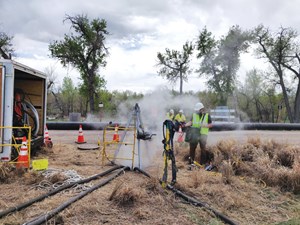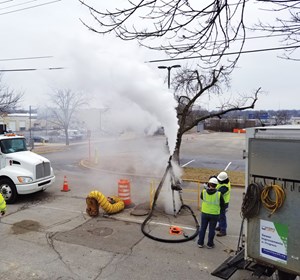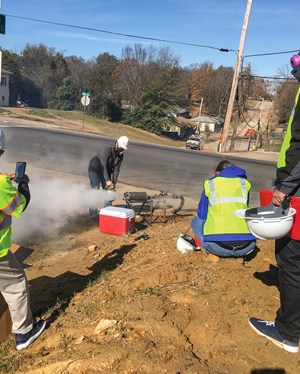April 2020 Vol. 75 No. 4
Rehab Technology
TTC Publishes Environmental Impact Study of Steam-Cured CIPP
Dr. John Matthews, Director, Trenchless Technology Center (TTC) and Dr. Elizabeth Matthews, Assistant Professor, Louisiana Tech University
In response to recent questions about the environmental impact of emissions from steam cured-in-place pipe (CIPP) projects, the Trenchless Technology Center (TTC) at Louisiana Tech University has published results from its extensive study related to the issue. This comprehensive project, which was funded by NASSCO and peer-reviewed by a large group of industry stakeholders, was undertaken to collect data from multiple projects under various climatic conditions and using varied sampling tools to determine the extent of potential impacts.
Study objectives were to evaluate air emissions from steam CIPP installations and then determine potential impacts to workers and the surrounding community. These objectives were accomplished by measuring worker exposure to emissions onsite and immediately offsite.
Selected construction sites represented a range of scenarios typical of CIPP installations, from small- to large-diameter, and various lengths and usage environments. The locations were chosen to capture job sites in various climates; however other limiting factors were considered, such as availability, project and site characteristics).
Study results were presented in a webinar, in December 2019, and the final report is now posted along with the recorded webinar on the NASSCO website. Also included on the website are responses to comments from the live webinar. Many of the comments were already addressed in the report, but further clarification is provided.
Key results
A full description of the methodologies and results can be found in the report; highlights are mentioned below.
Based on the broad sampling and testing in this project, the only two locations where styrene levels could potentially pose any health risks were inside the transport truck and near the emission stack. Styrene emissions from inside the transport trucks consistently measured between 100 ppm to 200 ppm, which could potentially pose health risks to workers if exposure exceeded 5 minutes.
It’s worth noting that none of the previous studies focused their testing at the transport truck location. It’s also worth mentioning that the samples were being analyzed for more than a dozen VOCs, but only styrene was found at any measurable level. This finding contrasted other studies that suggested multiple VOCs were being detected at significant levels.
Results for emissions near the stacks were mostly lower than the transport trucks, but potentially pose a risk if exposure durations approached 5 minutes. No measurement taken at 10 feet or more from the termination manhole and/or exhaust stack exceeded exposure limits. In fact, those levels were far below guideline levels. Several variables like wind, temperature and distance from the exhaust, affect the dispersion of styrene, which most likely explains the range in concentration values.
Of note here is that, while numerous measurements were taken at multiple sites using multiple methods, there was no corroboration of the extremely high values – regularly exceeding 500 ppm – previously published by some researchers. This calls the higher levels into question and led to this study, as several other studies in the past published results more closely aligned with the TTC study.
Finally, measurements taken in homes near exhaust points yielded styrene concentrations less than 0.01 ppm. This suggests there is little potential danger of styrene emissions collecting in homes and rising to levels above exposure limits. Further research on this topic is being conducted by other researchers and industry currently. Data collected by sorbent tubes mounted on workers or at points to approximate worker exposure revealed no episode where the exposures averaged over the duration of the installation exceeded any threshold limits. This would suggest that CIPP installers experience safe, long-term exposures to styrene.
Key recommendations
The opening of the liner transport truck door represents a point in the CIPP installation process where there is potential exposure to dangerous levels of styrene. It is assumed, however, that styrene levels begin to dissipate the moment the liner transport truck is opened and could drop to acceptable, short-term exposure levels soon after the door is opened.
For these reasons, the TTC recommends:
- For those immediately entering the liner transport truck or storage unit, active air monitoring should be utilized at the initial opening of the truck or storage unit door to ensure a safe work environment.
- At the initial opening of the liner transport truck or storage unit door, suitable PPE should be worn by those immediately entering the truck or storage unit.
These recommendations will ensure safe handling of the liner for nearly all potential levels of styrene.
The area very near the exhaust stack and/or termination manhole at a steam-cured CIPP installation site and any area contained within the visible plume of the exhaust points appear to be the job-site locations with the greatest potential for exposure to airborne styrene above the limits set by OSHA, NIOSH and the EPA/CDC.
Styrene measurements taken at the exhaust points could represent styrene levels that endure for portions of the curing process exceeding 5, 15 or 30 minutes. For these reasons, the TTC team recommends:
- A conservative perimeter of 15 feet be implemented around exhaust manholes/emission stacks during curing. This perimeter could be entered for less than 5 minutes. If entered for longer than 5 minutes, suitable PPE should be used.
- Emissions stacks should be a minimum of 6 feet tall to enhance the dispersion of emissions and lessen the likelihood of workers entering the perimeter from having to cross into the plume.
This recommendation will ensure safe operations around the stack areas for the duration of the lining project.
In areas surrounding the exhaust stack, the data suggests that styrene dissipates rapidly and that exposure to styrene above regulatory guideline limits is unlikely outside of a 15-foot radius around emissions points. Based on the data, it is also unlikely that styrene levels would rise to a level that presents any danger to residents inside buildings.
Future studies of CIPP emissions should focus on determining the time it takes liner truck emissions to dissipate and further evaluating specific task-oriented emission impacts. •
Acknowledgments
The authors acknowledge research team members at TTC (Dr. Shaurav Alam, Dr. Sven Eklund, Ashlesh Banjara, Hawa Hashm, Gazi Hossain, Jason Howell, John Kraft and ERDC), Dr. Anthony Bednar and Charles Laber.
The authors acknowledge financial support from NASSCO.







Comments